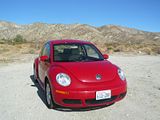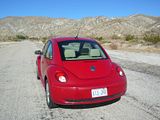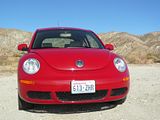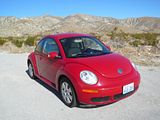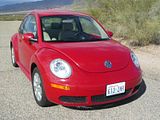One of the reasons why the VW Beetle achieved such an enormous sales success during its many years in production was because the Americans took the car to their hearts and bought it in literally their millions. Perhaps it should not have been too much of a surprise for Volkswagen, therefore that reaction to the Concept One car that took pride of place on VW’s stand at the Detroit Auto Show in 1994 was so enthusiastic. This retro themed car, styled in California, was based on the then current VW Polo platform, and truly looked like a modern reinterpretation of the classic Beetle. Buoyed by such a positive response, VW took the decision to put the car into production. It took until 1998 before the car was ready for sale, by which time the design had been adapted and enlarged a little and was now sitting on the same platform as the big selling Golf. It was an immediate sales success, with demand far exceeding supply. So much so that it took VW more than twelve months to commence production of right hand drive models, but that did not deter them from selling left hand drive cars in the UK market. In California, it was particularly popular and was the “must have” automotive fashion statement for a couple of years, with only the Chrysler PT Cruiser as a sort of rival. In 2001, VW followed up this success by recreating the Cabrio model, and this quickly became equally popular. Apart from a few minor modifications to the lights and trim, New Beetle, as the car was called, has been on sale unchanged ever since, making it one of the longest running production cars of the modern era. Other manufacturers spotted that the modern reinterpretation of classic and much loved designs could be made to work, with the Mini and the Fiat 500 being further examples of the genre. In recent years, sales have diminished more than somewhat, but it is no secret that an updated version of New Beetle is expected during 2011. Perhaps surprisingly, given the many years that the car has been on sale, I had yet to drive one, but when I spotted a Washington State plated Solar Red example parked up next to the behemoth that Hertz had allocated to me, I was able to effect a swap and get the keys to the car as the final rental vehicle of the November 2010 US trip.

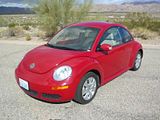
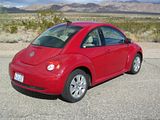

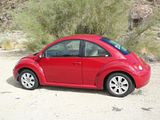
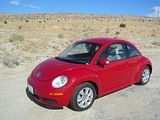
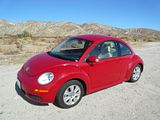
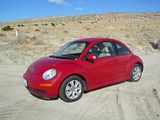
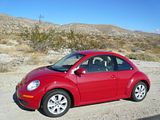
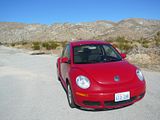
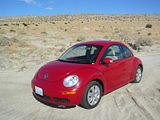
In Europe, New Beetle is still sold with a wide variety of petrol and diesel engines, and these choices have largely followed updates to VAG’s motive power offerings during the production life of New Beetle. In America, it is simple. There is only one engine offered, the 2.5 litre 5 cylinder motor, and it comes with a choice of five speed manual, or, as a cost extra, the six speed Tiptronic automatic gearbox. It is not much harder to decide on the trim spec, either, as the only choice is the S model, which can be upgraded to Blush, which simply gives you leather seats and 17″ wheels.
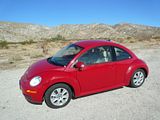
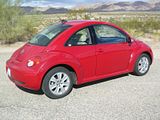
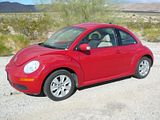
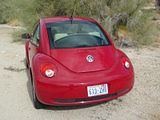
The engine in New Beetle is essentially the same as that in the Jetta I had sampled earlier in the same trip, though in this form it develops 20 bhp less, netting out at 150bhp. Start it up, and your ears tell you that it is neither a four nor a six, and whilst, like the Jetta, it is not always evident that you have the relatively unusual configuration of a five, it is more noticeable in this car than its stablemate. It is enough to make New Beetle decently brisk, though you would certainly not call it fast. The engine is willing, though and if you rev it even moderately, you do pick up speed quite well. The six speed auto seemed to suit the car’s character quite well, providing smooth fully automated changes for you. If you want to select the gears yourself, you can do that by pushing the lever to the right and then you can flick it forward and back for up and down changes. After the slightly disappointing consumption figures of some of the other relatively small cars sampled on this trip, I was pleased to calculate an average of just over 33mpg, US, which amounts to approximately 40 mpg Imperial, for New Beetle which was quite respectable.
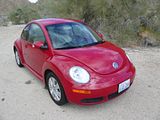
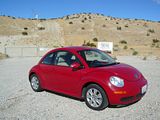

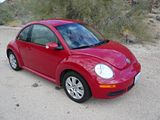
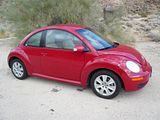
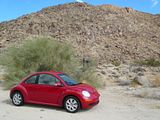
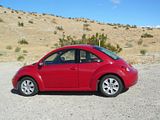
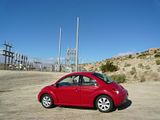
The PQ34 platform which underpinned Golf IV, and also sits under New Beetle was not particularly well regarded for endowing these cars with enthusiast level driving characteristics, but I found no particular issues during my test. Despite what you might conclude from many of the photos, where the sun is readily apparent, I actually experienced some terrible driving conditions with very heavy rain, lots of spray, strong winds and poor visibility. Accordingly, most of the test was carried out on the Freeway, heading east in quest of the dry, and this time I did not take this car up into the Canyon roads above Los Angeles as I would usually do. In these conditions, I was happy that the car was easy to drive, and had no issues. The steering is well weighted, and the car went round corners with no cause for alarm. The strong winds did not appear to challenge it, and even on some very wet roads, it would come to a standstill with no problems. The ride on California’s ever deteriorating surfaces seemed comfortable enough. Compared to most other cars on US roads, New Beetle is relatively small, and it is easy to position on the road. The steeply sloping front and rear mean that you cannot actually see either end of the car park when parking up, but I did not find this to be a problem. More challenging was the fact that the door mirrors are relatively small, and they did offer a fairly restricted view of what was coming up from behind and alongside the car.


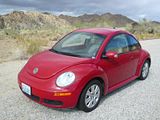

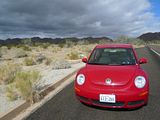
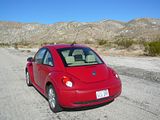
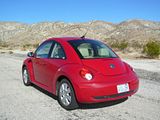
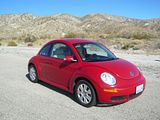
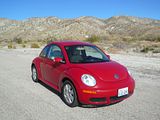
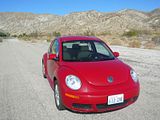

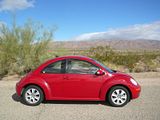
One of the consequences of modern car design, with steeply sloped front and rear screens is that the dash moulding which use to be a simple almost vertical panel under the base of the windscreen has got deeper and deeper, but none can match the enormity of that which I found in New Beetle. It is one of the reasons why there is relatively so little space inside the cabin for the size of car, as this massive moulding extends a long way from front to back. Just like the outside, the interior of the car is styled very much like the traditional Beetle. There is a single dial, which contains the speedometer and, as smaller gauges in the bottom of the dial, the rev counter and fuel gauge. These are the only instruments you get, with anything else being conveyed to you in the digital display panel in the middle of the speedo, which contains the odometer. Further homage to the original car’s style comes in the form of a vase holder to the right of the wheel, where you could put your single flower stalk. A large grab handles dominates the passenger’s side of the dashboard, though this car does also have an airbag in the upper part of the dash, which is something clearly which had not even been invented at the time of the first Beetle. The centre of the dash features a number of modern fittings which buyers expect these days, with an audio unit sitting above the rotary dials for the air conditioning system. These items, along with the column stalks and the rotary dial for lights to the left of the column are from the VW parts bin, unsurprisingly, which means that they are easy to use and of good apparent quality. There are other interior design features which recall the earlier model, such as the large area of body colouring – these days in plastic rather than painted metal – on the doors, and grab loops on the A pillars. The interior of the test car was a mixture of the red door caps, black and oatmeal, which had stood up very well to what would appear to be just over 2 years (but relatively low mileage, considering) rental car abuse. It was far less funereal than some other recent test cars, VW’s own Jetta included.


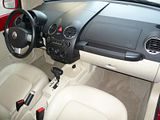
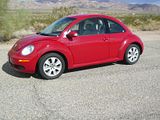
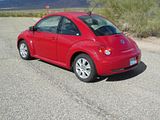

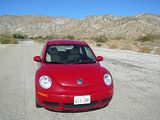
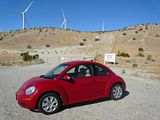
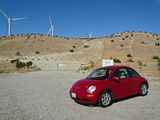
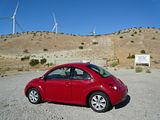
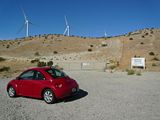

There is plenty of space for the front seat passengers, with headroom in particularly plentiful supply, and the occupants can enjoy a modern seat that is far more comfortable and supportive than anything that would have featured in the original car. Adjustments were all manual, but, in combination with the ability to move the steering column up and down and in and out, this all allowed me to get just the right driving position and to sit comfortably in the car as I headed east on the I10 freeway Access into the back of the car is easier than is often the case with a two door hatchback as the front seats have a cantilevered mechanism which tips them well forward out of the way. Once installed, though, space is surprisingly tight. This is definitely a car for no more than two people to sit in the back, and the design of the car will force them to sit towards the middle. They will struggle for headroom, too, finding their heads very likely to brush the roof at about the point where the tailgate and roof panel meet. Although it is externally somewhat larger than the Fiat 500, my perception is that there is hardly any more space in here. The boot is larger than in the Fiat, but not by much. A lot of this is a consequence of the very steeply sloped rear of the car. My suitcase occupied more or less the whole of the floor area of the boot, though it was deep enough to be able to put the PC back on top, and it all fitted under the rear parcel shelf (despite what the eagle eyed might see in some of the pictures!). More luggage space can be generated by folding the rear seats down. The rear seat cushion lifts up and forwards, as a single item, so although the backrests are split, if you want a flat load floor, you have to sacrifice both rear seats. Thus configured, there is plenty of space for luggage. The inside of the cabin is not particularly generously endowed with stowage space, either. There are nets on the doors, there is a moderate glovebox, a very small cubby inside the centre armrest and a tray in front of the gearlever.
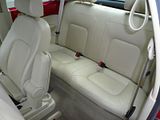
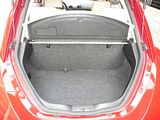
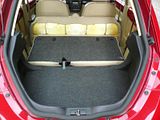
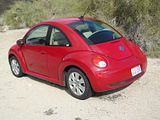
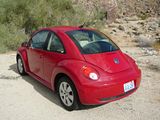

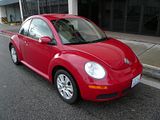
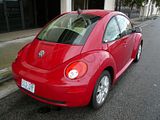
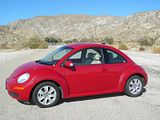
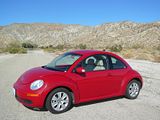
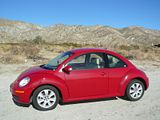
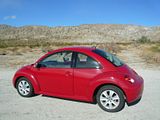
I suspect that few of the potential buyers of New Beetle will care too much about many of the negative points of the car. This is not really the sort of vehicle where a potential customer would undertake an exhaustive comparison of a number of market alternatives and select what according to their own criteria and preferences they then feel to be the “best”. Cars like New Beetle are much more designed to be bought by someone simply because they “want one”. For such customers, I suspect that they would be unlikely to be too disappointed, though the longevity of the model does mean that it is now a pretty common sight on the roads and that fact alone might diminish the potential appeal somewhat. For the rental car customer, if they can find one – and Hertz told me that they only have a few, and surprisingly, they did not think that any of them were California plated models – it could be an interesting option. Hertz rate the car as a Group B, their standard for compact cars, where it is up against the US Ford Focus, the Nissan Versa, Toyota Yaris Sedan and remaining examples of the Chevy Cobalt. None of those have anything like the urge of the 2.5 litre 5 that powers New Beetle and they all appear so utterly conventional, which indeed is what they are. Provided there are not four of you with a pile of luggage (in which case, a Compact Car was not the right class to have booked in the first place), it could be worth asking to have one of these if you spot one in the rental carpark.

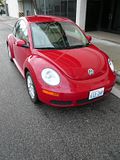
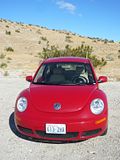
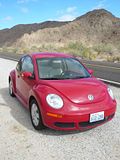

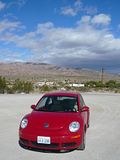
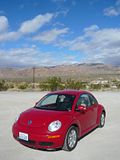
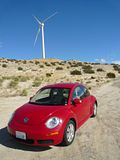
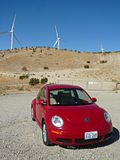
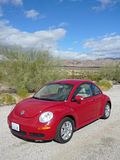
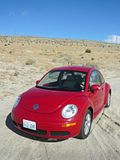
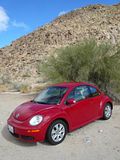
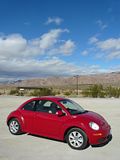

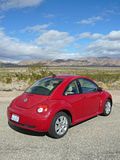
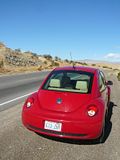
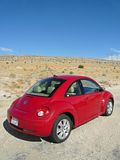
2010-12-10 08:31:00






































































